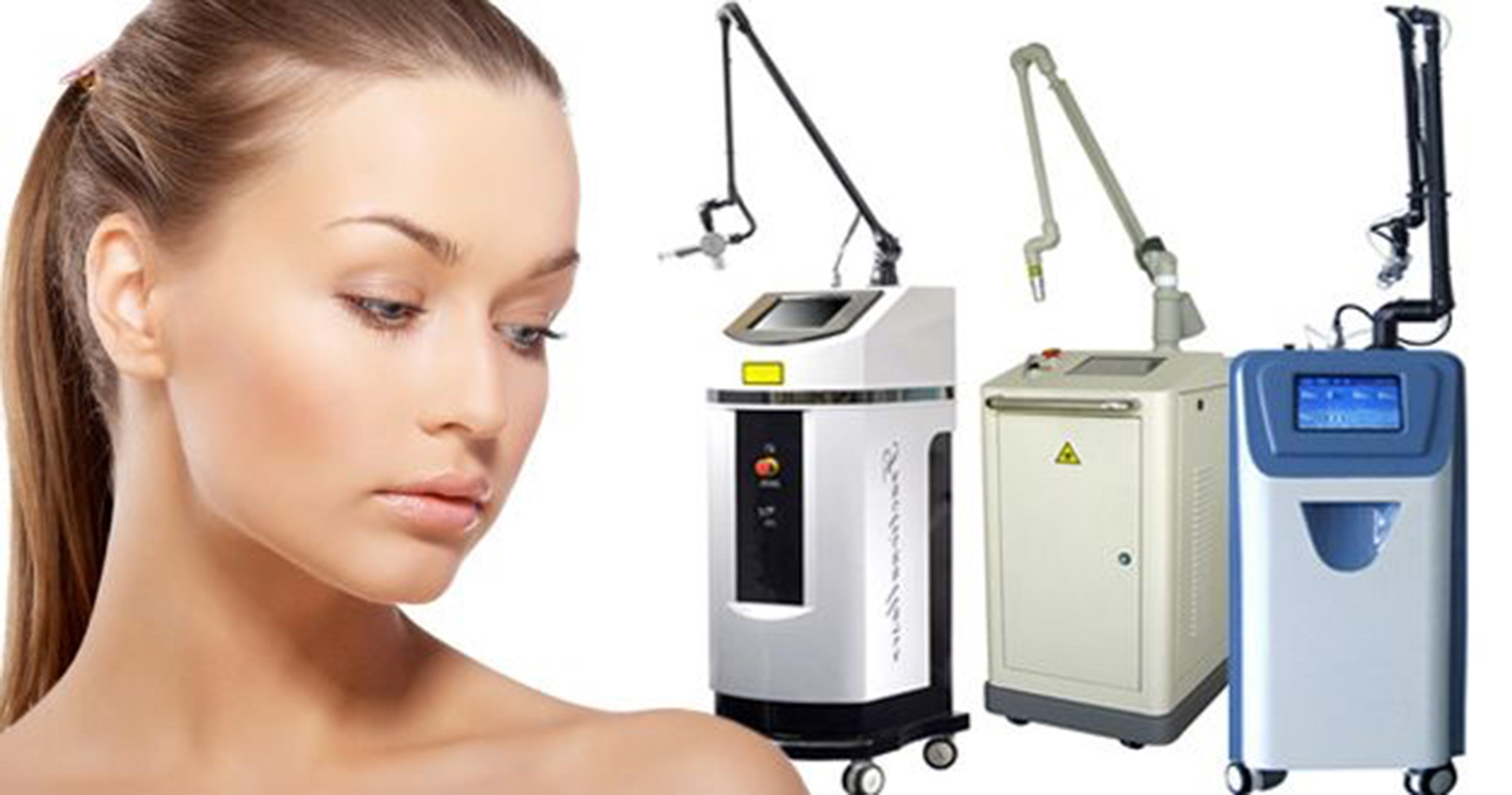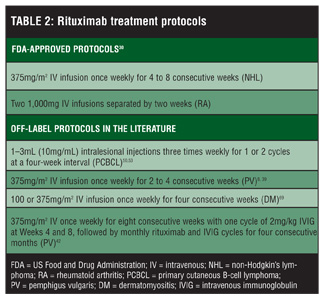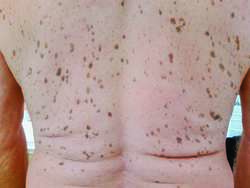Sunscreens are important photo-protective measures.
These are available in different SPF factors.
Higher the SPF the higher sun protection achieved.
SPF is sun protection factor.
It is a measure to assess protection against UVB radiations.
SPF= minimal erythema induced after exposure of sun protected skin
----------------------------------------------------------------------------
Minimal erythema induced after exposure of unprotected skin
UVA protection is also important for complete sun protection.
UVA protection is assessed on the basis of persistent pigment darkening (PPD).
It's called UVA -PF ( Ultraviolet A - protection factor).
Two different types of sunscreen :
Chemical and physical sunscreen
(Organic and inorganic)
Avobenzone is most commonly used UVA filter.
Octinoxate is widely used UVB filter.
Inorganic active ingredients :
Titanium dioxide and zinc oxide
These particles available in microfine particles ( nano particles) to avoid refraction of light.
Sunscreen should be applied 2 mg/cm2 to achieve accurate sun protection as labeled on sunscreen with SPF.
Controversies:
1) vitamin D:
With sunscreen application serum vitamin D levels which require sunlight will decrease or not??
The answer is No.
Most of the times people apply sunscreen inadequately so not affecting natural process of conversion of cholecalciferol ( vit D3).
The same UVB radiation is required for vit D synthesis so it's not acceptable to get exposed it to induce photocarcinogenesis.
Instead one can take vit D supplements and must continue photo protection with sunscreen .
2) melanoma and nonmelanoma skin cancer
Is sunscreen usage really helpful in reducing skin cancer on prolonged use??
Answer is yes.
Few scientific studies have established the effectiveness of sunscreen in decreased risk of development of skin cancer.
How often one should apply sunscreen ?
Every 2 hours sunscreen should be reapplied.
As sunscreen do migrate to skin surface through follicular orifice and lead to uneven distribution.
These can be removed with sweat and water. So reapplication is necessary to remain protected all time.
USAN : United States adopted nomenclature is used to name active ingredient of sunscreen .
Till date 16 active ingredients are included in list by FDA.
New generation sunscreen ingredients are more photo-stable one.
Photo allergy risks with active ingredients are relatively low.
Snehal Skin Care-We care your beauty!
Hi there, I am Dr. Snehal Thorat specialized in Dermatology and cosmetology. Presently taking advance training in lasers at China Medical University Hospital of Taiwan. If you have any skin related issues or about cosmetic problems, please contact me.
Sunday, October 9, 2016
Friday, September 30, 2016
Kimura disease
Kimura disease :
It's one of the rare condition ..
It is characterized by asymptomatic subcutaneous mass which enlarges gradually. Sometimes pruritus or ulcers may be accompanying symptoms.
Sites: head and neck region most commonly affected.
Others: trunk or extremities and sometimes inguinal or epitrochlear lymph nodes.
Superficial glands may be affected: parotid or submandibular gland
It's mostly solitary or can be multiple in number.
IgE and eosinophils are increased in such patients.
Renal system is affected with nephrotic syndrome presentation..
Differential diagnosis :
Lipoma
Subcutaneous tumor
Angiolymphoid hyperplasia with eosinophilia
Histopathology:
Cellular : increased eosinophils and follicular hyperplasia
Vascular : arborizing vascular proliferation of post capillary venules
Fibrocollagenous
Treatment :
Radical excision is first line therapy
Radiotherapy is second line
If multiple masses chemotherapy is preferred
If renal involvement steroids is the first choice.
Recurrence is possible at primary site or other sites.
It's one of the rare condition ..
It is characterized by asymptomatic subcutaneous mass which enlarges gradually. Sometimes pruritus or ulcers may be accompanying symptoms.
Sites: head and neck region most commonly affected.
Others: trunk or extremities and sometimes inguinal or epitrochlear lymph nodes.
Superficial glands may be affected: parotid or submandibular gland
It's mostly solitary or can be multiple in number.
IgE and eosinophils are increased in such patients.
Renal system is affected with nephrotic syndrome presentation..
Differential diagnosis :
Lipoma
Subcutaneous tumor
Angiolymphoid hyperplasia with eosinophilia
Histopathology:
Cellular : increased eosinophils and follicular hyperplasia
Vascular : arborizing vascular proliferation of post capillary venules
Fibrocollagenous
Treatment :
Radical excision is first line therapy
Radiotherapy is second line
If multiple masses chemotherapy is preferred
If renal involvement steroids is the first choice.
Recurrence is possible at primary site or other sites.
 |
| Parotid swelling with subcutaneous swelling on arm |
Tuesday, September 27, 2016
Laser principles
Laser and flash lamps in dermatology :
Laser works on principle of selective photothermolysis.
Leon Goldman started laser use in dermatology first time after discovery of lasers.
Flashlamps are intense pulsed light ( IPL) devices..
These lights use cut off filters so as to provide broad range of wavelengths of electromagnetic spectrum .
IPL can be available for versatile use in dermatology ..
Lasers are collimated monochromatic light energy delivered at specific wavelength with either continuous mode or pulsed waves with pre- determined pulse duration to destroy specific target.
Photons are the quantum of light energy. When photons are stimulated in excited medium they are capable of generating other photons exponentially. These stimulated emission of photons through the mirror with reflectivity <100% concentrated on lens to form laser beam on fiber.
So the name: LASER: light amplification by stimulated emission of radiation .
Selective photothermolysis :
Laser destroys the target inside skin very specifically without damage to adjacent tissue
Basic parameters of optical radiation:
Energy = power * time
Intensity= power/ area
Fluence = power* time /area
Radiant exposure for IPL is determined by size of applicator and energy of radiation.
Energy is expressed in terms of joules.
Fluence is expressed in J/cm2.
Longer the wavelength between 400-1200 nm the more deeper the penetration in the skin.
Lasers are classified as
1)Continuous wave (>0.2 s)
2) pulsed mode (0.2 s-1 micro second)
3) quality switch lasers ( 1 micro second - 1 ns)
Interaction of radiation with skin:
When radiation penetrate the skin the following process can happen:
1) scattering
2) reflection
3) absorption
So when we decide the laser wavelength we should take these optic physics into consideration.
Eye safety is must because of reflection of light.
UVR and Infrared light can not be visible to eye so more chance of damage without perception.
Possible eye injuries range from cornea damage, retina injury, cataracts to permanent blindness.

Laser works on principle of selective photothermolysis.
Leon Goldman started laser use in dermatology first time after discovery of lasers.
Flashlamps are intense pulsed light ( IPL) devices..
These lights use cut off filters so as to provide broad range of wavelengths of electromagnetic spectrum .
IPL can be available for versatile use in dermatology ..
Lasers are collimated monochromatic light energy delivered at specific wavelength with either continuous mode or pulsed waves with pre- determined pulse duration to destroy specific target.
Photons are the quantum of light energy. When photons are stimulated in excited medium they are capable of generating other photons exponentially. These stimulated emission of photons through the mirror with reflectivity <100% concentrated on lens to form laser beam on fiber.
So the name: LASER: light amplification by stimulated emission of radiation .
Selective photothermolysis :
Laser destroys the target inside skin very specifically without damage to adjacent tissue
Basic parameters of optical radiation:
Energy = power * time
Intensity= power/ area
Fluence = power* time /area
Radiant exposure for IPL is determined by size of applicator and energy of radiation.
Energy is expressed in terms of joules.
Fluence is expressed in J/cm2.
Longer the wavelength between 400-1200 nm the more deeper the penetration in the skin.
Lasers are classified as
1)Continuous wave (>0.2 s)
2) pulsed mode (0.2 s-1 micro second)
3) quality switch lasers ( 1 micro second - 1 ns)
Interaction of radiation with skin:
When radiation penetrate the skin the following process can happen:
1) scattering
2) reflection
3) absorption
So when we decide the laser wavelength we should take these optic physics into consideration.
Eye safety is must because of reflection of light.
UVR and Infrared light can not be visible to eye so more chance of damage without perception.
Possible eye injuries range from cornea damage, retina injury, cataracts to permanent blindness.
Monday, August 29, 2016
steatocystoma multiplex
Steatocystoma multiplex:
Definition:
It is also called as epidermal poly cystic disease.
There are numerous epithelial lined sebum filled dermal cysts with characteristic sebaceous gland in the cystic wall.
Associated with Alagille syndrome and pachyonychia congenita type 2.
In these cases defect is K17 mutations.
It can be sporadic occurrence or inherited as autosomal dominant.
Clinical presentation:
Skin coloured cysts on trunk, upper arms, scrotum and chest.
No symptoms
Complication: suppurations and sinus formation leading to scarring.
When single cyst is present in sporadic manner it's called steatocystoma simplex.
Pathological findings:
Cyst is lined by stratified squamous epithelium but no granular layer and sebaceous glands are located on cyst wall.
Eosinophilic cuticle on luminal side of this wall with hair and keratin inside it.
Differential diagnosis: eruptive vellus hair cyst
Epidermal inclusion cyst
Treatment:
Surgical excision
Cyst drainage with manual removal of cyst.
Inflamed lesions can be treated with oral retinoids, cryotherapy or CO2 laser or intralesional steroids.
Definition:
It is also called as epidermal poly cystic disease.
There are numerous epithelial lined sebum filled dermal cysts with characteristic sebaceous gland in the cystic wall.
Associated with Alagille syndrome and pachyonychia congenita type 2.
In these cases defect is K17 mutations.
It can be sporadic occurrence or inherited as autosomal dominant.
Clinical presentation:
Skin coloured cysts on trunk, upper arms, scrotum and chest.
No symptoms
Complication: suppurations and sinus formation leading to scarring.
When single cyst is present in sporadic manner it's called steatocystoma simplex.
Pathological findings:
Cyst is lined by stratified squamous epithelium but no granular layer and sebaceous glands are located on cyst wall.
Eosinophilic cuticle on luminal side of this wall with hair and keratin inside it.
Differential diagnosis: eruptive vellus hair cyst
Epidermal inclusion cyst
Treatment:
Surgical excision
Cyst drainage with manual removal of cyst.
Inflamed lesions can be treated with oral retinoids, cryotherapy or CO2 laser or intralesional steroids.
Monday, August 15, 2016
Lasers
Therapeutic applications of lasers:
1. Tattoo removal
2. Vascular lesions:
A. Telangiectasia
B. Port wine stain
C. Infantile haemangioma
E. Venous lake
F. Starburst veins
G. Varicose veins
H. Lymphangioma circumscripta
I. Tuberous sclerosis ( angiofibromas)
3. Tumors:
A. Trichoepithelioma
B. Neurofibromas
C. digital mucous cyst
D. Xanthelesma
E. Syringomas.
 4. Nevi:
4. Nevi:
A. Epidermal nevus
B. Sebaceous nevi
C. Congenital melanocytic nevus
D. Nevus of Ota
E. Nevus zygomaticus
F. Nevus pigmentosus
5. Hair removal
6. Alopecia areata
7. Vitiligo
8. Keloid and hypertrophic scars
9. Acne and acne scars
10. Seborrhoeic keratoses
11. Freckles
12. Solar lentigo
1. Tattoo removal
2. Vascular lesions:
A. Telangiectasia
B. Port wine stain
C. Infantile haemangioma
E. Venous lake
F. Starburst veins
G. Varicose veins
H. Lymphangioma circumscripta
I. Tuberous sclerosis ( angiofibromas)
3. Tumors:
A. Trichoepithelioma
B. Neurofibromas
C. digital mucous cyst
D. Xanthelesma
E. Syringomas.
 4. Nevi:
4. Nevi:A. Epidermal nevus
B. Sebaceous nevi
C. Congenital melanocytic nevus
D. Nevus of Ota
E. Nevus zygomaticus
F. Nevus pigmentosus
5. Hair removal
6. Alopecia areata
7. Vitiligo
8. Keloid and hypertrophic scars
9. Acne and acne scars
10. Seborrhoeic keratoses
11. Freckles
12. Solar lentigo
13. Skin resurfacing
Monday, August 8, 2016
Biological therapy in dermatology
Rituximab 375mg/m2 weekly for 4weeks in pemphigus
Mechanism of action for Rituximab:
It is anti CD20 monoclonal antibody.
Biological agents in psoriasis:
1) Ustekinumab:
45 mg SC on week 0,4, then every 12 weeks
2) Secukinumab:Initial: 300 mg SC at weeks 0, 1, 2, 3, and 4
Monthly maintenance: Beginning at week 8, give 300 mg SC once monthly
For some patients, a dose of 150 mg may be acceptable
3) Adalimumab: 80mg SC on day 1
40mg on day 8
40 mg every 2 weeks
These agents can be combined with phototherapy or methotrexate.
Mechanism of action for Rituximab:
It is anti CD20 monoclonal antibody.
1) Ustekinumab:
45 mg SC on week 0,4, then every 12 weeks
2) Secukinumab:Initial: 300 mg SC at weeks 0, 1, 2, 3, and 4
Monthly maintenance: Beginning at week 8, give 300 mg SC once monthly
For some patients, a dose of 150 mg may be acceptable
3) Adalimumab: 80mg SC on day 1
40mg on day 8
40 mg every 2 weeks
These agents can be combined with phototherapy or methotrexate.
Ustekinumab has shown maximum disease free period after treatment.
Remember:
All biological agents are found to be less effective in obese patients when used as a monotherapy.
Adalimumab can be used in hidradenitis suppurativa cases.
First generation biological agents for psoriasis: etarncept, Adalimumab, inflixiamb
These agents target TNF -alpha.
Second generation: Ustekinumab acts against IL-12/23( pro- inflammatory cytokines)
Third generation: targets IL-17.
Remember:
All biological agents are found to be less effective in obese patients when used as a monotherapy.
Adalimumab can be used in hidradenitis suppurativa cases.
First generation biological agents for psoriasis: etarncept, Adalimumab, inflixiamb
These agents target TNF -alpha.
Second generation: Ustekinumab acts against IL-12/23( pro- inflammatory cytokines)
Third generation: targets IL-17.
Tuesday, August 2, 2016
Seborrheic keratoses
Seborrheic keratoses (SK) :
It's a benign epidermal tumour.
It is commonly present in old age.
It's types:
1) Common seborrheic keratoses
2) Skin tags
3) Irritant SK
4) Pigmented SK
5) SK with squamous atypia
6) Stucco keratoses
7) Leser trelat sign
8) Reticulated SK
9) Dermatosis papulosa Nigra (DPN)
10) Clonal SK
Histopathology:
Acanthosis, papillomatosis, pseudo cyst formation, hyper keratosis.
Clinical features:
Stuck on appearance of lesion
Treatment:
Cryotherapy
Electric desiccation
Laser
Surgical excision
Topical flurouracil
Biopsy is recommended when
Rapid growth of lesion
Atypical clinical appearance
Symptomatology
Unusual lesion location
In the above features there is risk of malignant transformation.
Irritant SK may develop in patients who are on chemotherapy especially cytarabine drug.
Lesar Trelat sign:
Eruption of SK on trunk in Christmas tree pattern
Cause: underlying adenocarcinoma of stomach most commonly
Other: adenocarcinoma of lung and colon.
DPN :
Present in skin type 4 and above.
It's a benign epidermal tumour.
It is commonly present in old age.
It's types:
1) Common seborrheic keratoses
2) Skin tags
3) Irritant SK
4) Pigmented SK
5) SK with squamous atypia
6) Stucco keratoses
7) Leser trelat sign
8) Reticulated SK
9) Dermatosis papulosa Nigra (DPN)
10) Clonal SK
Histopathology:
Acanthosis, papillomatosis, pseudo cyst formation, hyper keratosis.
Clinical features:
Stuck on appearance of lesion
Treatment:
Cryotherapy
Electric desiccation
Laser
Surgical excision
Topical flurouracil
Biopsy is recommended when
Rapid growth of lesion
Atypical clinical appearance
Symptomatology
Unusual lesion location
In the above features there is risk of malignant transformation.
Irritant SK may develop in patients who are on chemotherapy especially cytarabine drug.
Lesar Trelat sign:
Eruption of SK on trunk in Christmas tree pattern
Cause: underlying adenocarcinoma of stomach most commonly
Other: adenocarcinoma of lung and colon.
DPN :
Present in skin type 4 and above.
Subscribe to:
Posts (Atom)









